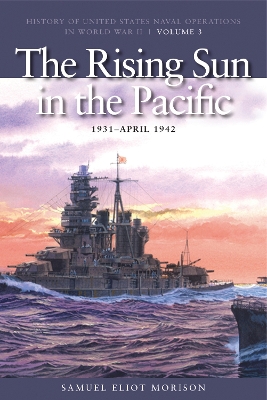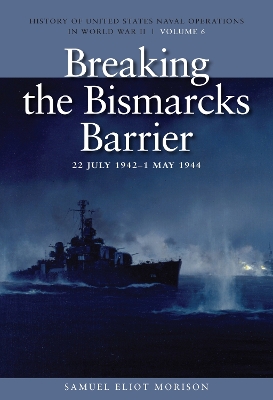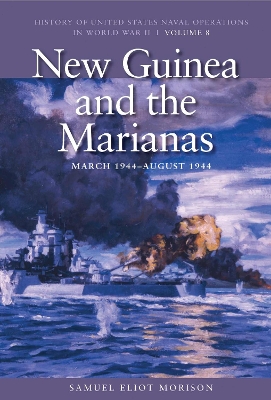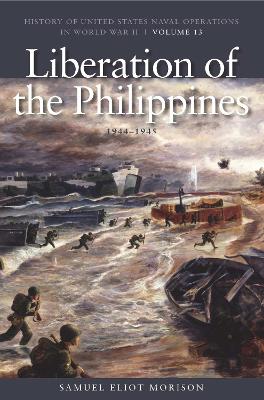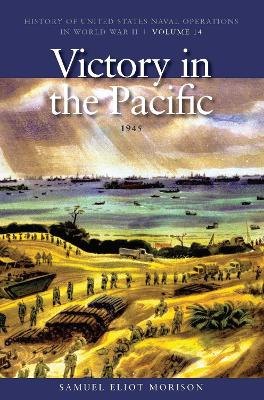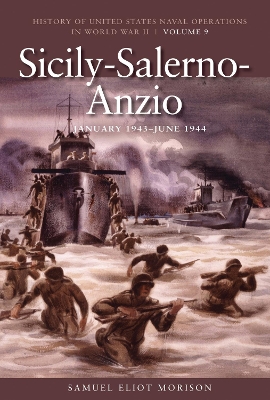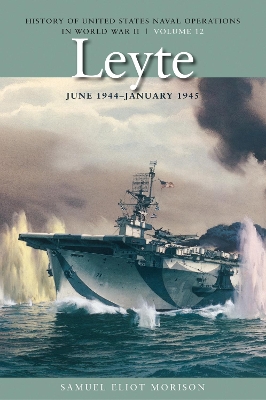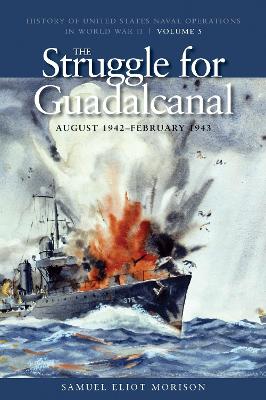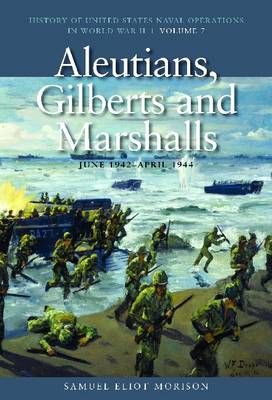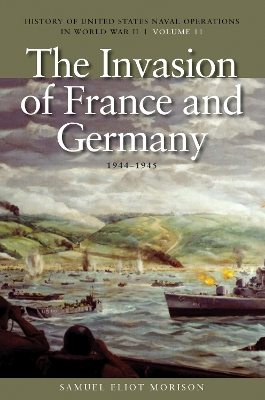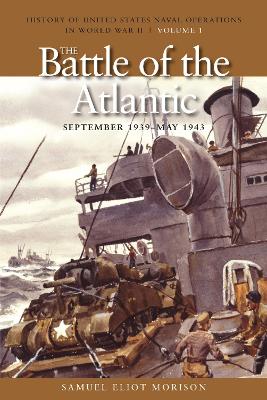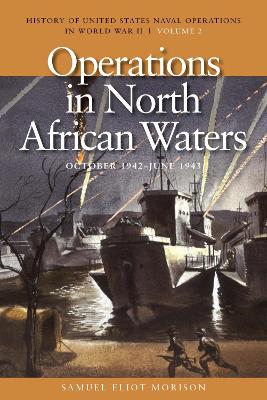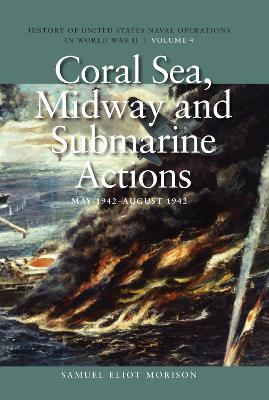U.S. Naval Operations in World War 2
14 total works
The first two volumes of this firsthand history of the U.S. Navy in World War II covered operations in the Atlantic from September 1939 to June 1943. Volume 3, THE RISING SUN IN THE PACIFIC, 1931-APRIL 1942 is the first on the war in the Pacific, a major testing ground which proved the ability of American naval forces to come back from disaster and eventually achieve its far-flung objectives. Considerable attention is given in this book to the "incidents" that really began the war in the Pacific and to the internal conflict within Japan.
The first four chapters cover the period up to December 1941 followed by a chapter on the attack, a brilliant account in detail of what actually happened at Pearl Harbor. Part II discusses"The Philippines and Near-by Water," including the invasion, the fall of Guam, the landings in Malaya and the rear guard in the Philippines. Part III is called "Out from Pearl" and deals with the aftermath of Pearl Harbor, Wake Island, communications and carrier strikes (January to March, 1942). Part IV, "Defense of the Malay Barrier," begins with the Abda Command of January to March, 1942, tells of Balikpapan, the prelude to the invasion of Java, the battle of the Java Sea, events in the Indian Ocean and finally the Halsey-Doolittle raid on Tokyo in April 1942. Data secured in Japan by a member of Captain Morison's staff, completes the absolutely authentic record of this volume.
Breaking the Bismark's Barrier, 22 July 1942 - 1 May 1944
by Samuel Eliot Morison
Volume 6 traces the gradual turning of the Pacific war from the overconfident Japanese to the dogged, undersupplied Allies. It examines the pivotal Papuan campaign, the Huan Gulf and Bougainville campaigns, and the conflicts that lead to the taking of Rabual.
About the Author
Samuel Eliot Morison taught at Harvard from 1915 to 1955, except for active duty service in the Navy where he attained the rank of rear admiral. The author of many books, he is the recipient of two Pulitzer Prizes and two Bancroft Prizes. He died in 1976.
New Guinea and the Marianas, March 1944 - August 1944
by Samuel Eliot Morison
Here, also, is the story of the Pacific Fleet operations from the end of the Marshall Islands campaign to the recovery of Guam. The battle of the Philippine Sea in June, a naval action equal to Midway in tactical interest, and decisive in the outcome of the war, receives particular emphasis as the greatest carrier action of all time– the Jutland of World War II. The first two assaults of Operations “Galvanic” and “Flintlock” of Volume VII were “sudden death” affairs, but the bitterly contested Marianas operation lasted two months. Events forced changes in the original plans, and our naval and ground forces displayed the greatest flexibility and fortitude.
About the Author
Samuel Eliot Morison taught history at Harvard from 1915 to 1955, except for active duty service in the Navy on board eleven different ships in all theatres of the war. In addition to this series, Rear Admiral Morison wrote many other popular and award-winning books on maritime history, including Two Ocean War. Morison, who died in 1976, was the recipient of two Pulitzer Prizes, two Bancroft Prizes, and the Presidential Medal of Freedom.
Liberation of the Philippines: Luzon, Midanao, Visayas, 1944-1945
by Samuel Eliot Morison
Through Admiral Samuel Morison's eloquence, the half-forgotten, far-off names of these Philippine battles come to life again, as he tells of the preliminary bombardments, the assaults over the beaches, and the land fighting for the islands and Manila, as well as of the countermeasures taken against the fanatical air attacks of the Japanese. Here too is Admiral Halsey's famous raid of Task Force 38 in the South China Sea, ranging from Formosa to Indochina. Of particular interest to sailors and landsmen alike is the chapter on the frightful typhoon of 18 December, 1944, in which three U.S. ships went down and over eight hundred lives were lost.
Additional chapters tell the story of the three amphibious assaults on Borneo by Australian troops covered by the U.S. Navy; of submarine operations in the southwest Pacific in 1945; and of Captain Milton Miles's amazing U.S. Naval Group, China, which carried out cloak-and-dagger operations on the mainland for years and fought the last naval battle of the war with sailing junks.
About the Author
Samuel Eliot Morison taught history at Harvard from 1915 to 1955, except for active duty service in the Navy on board eleven different ships in all theatres of the war. Before he died in 1976, he was the recipient of two Pulitzer Prizes, two Bancroft Prizes, and the Presidential Medal of Freedom.
With his usual clarity and skill, Morison describes the strategy that led to the concluding campaigns of the war and to the dropping of the first atomic bombs. Additional chapters are devoted to the logistics problem of supplying fleets and armies thousands of miles from bases to the devastating prowls by Pacific Fleet submarines, and to the controversial loss of the Indianapolis.
Of particular interest is his detailed account, from Japanese and American sources, of the delicate negotiations which led to the surrender of Japan.
About the Author
Samuel Eliot Morison, an eminent Harvard professor, was appointed by close friend Franklin D. Roosevelt to write the history of U.S. naval operations during World War II after convincing the president that too many wartime histories were written after the fact or from a distance. Morison called his classic work a“shooting history” of World War II, because it was documented by historical observation during each specific naval operation in the Atlantic and Pacific. Hailed for its accuracy, narrative pace and detail, this monumental work presents a complete record of the
U.S. Navy’s war at sea, covering the strategic planning, battle tactics, and technological advances, as well as the heroic actions of American sailors.
As the operations in this volume were both joint and combined, it covers a great many besides those of the United States Navy, also providing a balanced account of Mediterranean operations in 1943-1944. As he relates the individual exploits of American bluejackets, he also discusses higher strategy, such as the British concept of nourishing operations in the"Sea of Destiny".
This is but one of the many controversial subjects covered in this volume. Morison considered that the whole plan of the Sicilian operation was ill-conceived, that the evacuation of three German divisions from Sicily could and should have been prevented, that the Italian armistice was woefully bungled, and that the hard-fought Anzio operation was a mistake. He concluded, however, that the Italian campaign, like the Wilderness campaign of 1864,"was fought because it had to be fought."
About the Author
Samuel Eliot Morison taught history at Harvard from 1915 to 1955, except for active duty service in the Navy on board eleven different ships in all theatres of the war. Before he died in 1976, he was the recipient of two Pulitzer Prizes, two Bancroft Prizes, and the Presidential Medal of Freedom.
Morison's account includes the key engagements surrounding the taking of Leyte: the U.S. Navy's extraordinary display of"gallantry, guts, and gumption" at the Battle of Samar and the perfect timing and almost faultless execution achieved in the Battle of Surigao Strait, the last naval battle in which air power played no part.
About the Author
Samuel Eliot Morison, an eminent Harvard professor, was appointed by close friend Franklin D. Roosevelt to write the history of U.S. naval operations during World War II after convincing the president that too many wartime histories were written after the fact or from a distance. Morison called his classic work a"shooting history" of World War II, because it was documented by historical observation during each specific naval operation in the Atlantic and Pacific. Hailed for its accuracy, narrative pace, and detail, this monumental work presents a complete record of the US Navy's war at sea, covering the strategic planning, battle tactics, and technological advances, as well as the heroic actions of American sailors.
The Struggle for Guadalcanal, August 1942 - February 1943
by Samuel Eliot Morison
Volume 5 covers the six major engagements in waters surrounding Guadalcanal, from the Solomon Islands campaign to the courageous actions of Edson's Raiders at the Battle of the Bloody Ridge.
About the Author
Samuel Eliot Morison taught at Harvard from 1915 to 1955, except for active duty service in the Navy where he attained the rank of rear admiral. The author of many books, he is the recipient of two Pulitzer Prizes and two Bancroft Prizes. He died in 1976.
Morison describes the development of new weapons on both sides that revolutionised the art of antisubmarine warfare: acoustic torpedoes, guided missiles, the hedgehog, the snorkel, the airborne microwave radar, the sonobuoy, and the"huff-duff" or high-frequency direction-finder. With thrilling immediacy, he chronicles air attacks on U-boats in the Bay of Biscay, hunter-killer groups that protected escort carriers by hunting down wolf-packs of German submarines, skirmishes conducted by radar under cover of darkness and heavy fog, and the dramatic sinking of the Scharnhorst in the North Atlantic. Bristling with action as well as fascinating technical detail, Morison's account brilliantly conveys the interplay of suspense and surprise as first one side, then the other gained the advantage.
About the Author
Samuel Eliot Morison, an eminent Harvard professor, was appointed by close friend Franklin D. Roosevelt to write the history of U.S. naval operations during World War II after convincing the president that too many wartime histories were written after the fact or from a distance. Hailed for its accuracy, narrative pace, and detail, this monumental work presents a complete record of the U.S. Navy's war at sea, covering the strategic planning, battle tactics, and technological advances, as well as the heroic actions of American sailors.
Aleutians, Gilberts and Marshalls, June 1942 - April 1944
by Samuel Eliot Morison
Two great amphibious operations are covered in this volume: the Gilbert Islands and the conquest of the Marshalls. Captain Morison, who took part in Operation: Galvanic, describes in detail the planning, preparation, and execution of the assaults on Makin and Tarawa, with a frank discussion of the mistakes.
The grim narrative of one of the most inspired and successful amphibious operation of the war contrasts with several amusing interludes including how the Japanese fooled US troops in the evacuation of Kiska.
About the Author
Samuel Eliot Morison taught history at Harvard from 1915 to 1955, except for active duty service in the Navy on board eleven different ships in all theatres of the war. In addition to this series, Rear Admiral Morison wrote many other popular and award-winning books on maritime history, including Two Ocean War. Morison, who died in 1976, was the recipient of two Pulitzer Prizes, two Bancroft Prizes, and the Presidential Medal of Freedom.
Morison covers the vital capture of Cherbourg as an invasion port and the diversionary landings in southern France that, together with Overlord, comprised the two main operations in the invasion of Europe in which the U.S. Navy played a leading part. At every stage, the fate of thousands of men depended not only on their own raw courage and resourcefulness but on quirks of timing and sheer luck. Morison offers a magnificent chronicle of these heroic days that definitively turned the tide of the war in Europe.
About the Author
Samuel Eliot Morison, an eminent Harvard professor, was appointed by close friend Franklin D. Roosevelt to write the history of U.S. naval operations during World War II after convincing the president that too many wartime histories were written after the fact or from a distance. Morison called his classic work a"shooting history" of World War II, because it was documented by historical observation during each specific naval operation in the Atlantic and Pacific. Hailed for its accuracy, narrative pace, and detail, this monumental work presents a complete record of the U.S. Navy's war at sea, covering the strategic planning, battle tactics, and technological advances, as well as the heroic actions of American sailors.
The Battle of the Atlantic, September 1939 - May 1943
by Samuel Eliot Morison
First published by Little Brown and later by the University of Illinois, the complete series will now be published by the Naval Institute Press in updated paperback editions with new introductions by noted military historians.
THE BATTLE OF THE ATLANTIC, SEPTEMBER 1939- MAY 1943 is the first volume of what Morison called his "shooting history" of World War II, because it was documented by historical observation during each specific naval operation.
While first chronologically, it was actually the second in order of publication. The first to be published was Volume II, OPERATIONS IN NORTH AFRICAN WATERS, October 1942-June 1943, of which Fletcher Pratt wrote in the New York Sun,"If the remaining volumes are up to the level of this one, it will stand not only as the most complete, but also the most readable work of its kind ever published."
Operations in North African Waters, October 1942 - June 1943
by Samuel Eliot Morison
One of America's most distinguished historians, Samuel Eliot Morison, was commissioned in the Naval Reserve early in 1942 with the sole duty of preparing the history of which OPERATIONS IN NORTH AFRICAN WATERS, OCTOBER 1942- June 1943, is the second volume. The work, as a whole, is a "shooting history," written from the inside out, in effect simultaneously with the events it records. Morison spend more that half his time a sea during the war, seeing active duty on eleven different ships and emerging with seven battle stars on his service ribbons. Either he or one of three officers on this staff personally covered every major operation after 1942. His is the story of naval combat, surface actions, submarine and antisubmarine warfare as conducted from carriers and naval bases ashore, and amphibious warfare.
Volume 2, which was actually the first to be published, covers naval aspects of Operation"Torch," the North African campaign, which carried out the plan favoured by President Roosevelt for opening a second front to relieve the Russians. Told with the accuracy of a historian, the pace of an experienced narrator, the detail of firsthand observation and participation, it is a full record of what was, at the time it occurred, the largest overseas expedition ever undertaken.
Coral Sea, Midway and Submarine Actions, May 1942 - August 1942
by Samuel Eliot Morison
Volume 4 takes a richly detailed look at the first two naval battles in which aircraft played the defining role. The exploits of the fledgling American submarine corps in the Pacific are also fully examined. Critical information from the Japanese is included.
About the Author
Samuel Eliot Morison taught at Harvard from 1915 to 1955, except for active duty service in the Navy where he attained the rank of rear admiral. The author of many books, he is the recipient of two Pulitzer Prizes and two Bancroft Prizes. He died in 1976.
